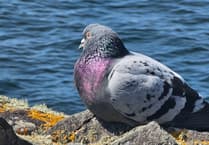The Ostrich
As the common ostrich weighs between 250 and 350 pounds there would be plenty of meat.
It is also the tallest and heaviest bird in the world. Their eggs are on the large side, too. A hen can lay a couple of eggs a week between April and September and, evidently, they taste slightly sweeter than a chicken egg and weigh just over one pound.
Many people will remember the ostrich farm in Woking, at Mizen’s Farm until Mizen’s was taken over by McLaren.
Speaking of which company, apart from sounding the death knell for the ostrich farm, didn’t McLaren’s promise an explanatory presence in the town, to tell the townsfolk the whys and wherefores of the building on the common, as part of the company being allowed to build there? It didn’t come about. I demand an explanation!
Back to the birds: Mizen’s were granted a licence by the borough council in December 1994 to farm ostriches and started off with about 130 of them the following month. These birds would provide fat-free meat, worth about £17 per pound at that time. In November they gave up their firework display so as not to annoy the birds.
Unfortunately the birds were annoyed in another way which was considerably worse for them than fireworks. Dogs. The Woking Informer for February 1995 reported that a golden labrador and a greyhound ripped through the fence at the farm. “One bird, worth £5,000, was chased onto a fence where it ripped its neck and had to be put down.’’ Two other birds were injured but recovered. I don’t know what happened to the dogs, but they were lucky: an ostrich can run at 43 mph and can deliver a dangerous kick.
By December 1995 McLaren made a bid to take over Mizen’s farm, with considerable opposition. Exit ostriches. In 1997 Woking planners were asked to consider another ostrich farm, off Prey Heath Road, which attracted more opposition and it would seem nothing came of this. What happened to the ostriches? Did they end up on dinner plates, or in a safari park – perhaps alongside Shane the Woking Lion(ess) even though an ostrich has been known to kill a lion!
I have, in the past, had good reason to thank Mr Google for information but, for information on local matters, such as lions and ostriches, I am indebted to the efforts of Richard and Rosemary Christophers.
In the wet
Following the recent excessively damp period of weather I thought I would take a look a the Rive Ponds on Wheatsheaf Common which were dug “to reduce local flooding and improve the amenity and nature conservation value” of the area.
It was last February that some 3,000 whips were planted there by about 160 volunteers: my daughter and I were among that group but, arriving somewhat late, we planted less than half a dozen between us.
Whilst walking in the area I have been asked, on several occasions, what trees were chosen. Hazel, rowan, field maple, and black alder were planted about a metre apart between the existing mature pines and the flatter areas next to the ponds. Guelder rose, alder, buckthorn, and hawthorn were planted very close together to form a dense hedge barrier along the Chertsey Road to help keep out traffic noise and exhaust fumes.
Last year it seemed that most of the whips had taken, but at this time of year there are, of course, very few signs of life. The ponds were not overflowing, as I thought might be the case, but the ditches feeding them were very high and, in places, topping their banks.
The network of paths has settled down and no longer look brash and new and have mainly stayed puddle free. It isa lovely place to walk.
But I do wish the barrier beside the Chertsey Road would hurry up and grow thickly, and cut down the traffic noise.





Comments
This article has no comments yet. Be the first to leave a comment.